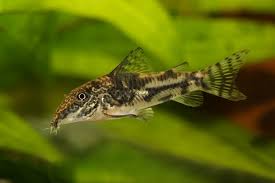
Corydoras catfish
Conditions of detention
Corydoras catfish are hardy and adaptable, thriving in a variety of aquarium setups. They prefer a well-planted tank with a soft, sandy substrate to protect their delicate barbels as they forage for food. A minimum tank size of 20 gallons is recommended, though larger tanks are ideal, especially for groups. Corydoras prefer slightly acidic to neutral water with a pH range of 6.0 to 7.5 and temperatures between 72-78°F (22-26°C). They are social fish and should be kept in groups of at least five to encourage natural schooling behavior.
Useful Fact: Corydoras catfish are schooling fish and are happiest when kept in groups of five or more, which helps reduce stress and encourages natural behaviors.
Nutrition and diet
Corydoras catfish are omnivorous and have a varied diet. They thrive on high-quality sinking pellets or wafers, which are specially designed for bottom feeders. They should also be fed live or frozen foods such as bloodworms, brine shrimp, and daphnia, as well as blanched vegetables like zucchini, spinach, and cucumber. While they help keep the tank clean by scavenging for leftover food, it’s important to provide them with a balanced diet to ensure they receive adequate nutrition.
Useful Fact: Corydoras are excellent scavengers but should not rely solely on leftover food; they require a dedicated feeding routine to stay healthy.
Health
Corydoras catfish are generally hardy and disease-resistant, but they can be susceptible to common freshwater diseases such as ich, fin rot, and bacterial infections, particularly if water quality is poor. They are also prone to stress-related issues if kept in isolation or in tanks with aggressive tankmates. Regular monitoring of water parameters and maintaining a clean environment are essential for keeping Corydoras healthy.
Useful Fact: Corydoras catfish are particularly sensitive to poor water quality and should be kept in a well-maintained tank with regular water changes to prevent stress and disease.
Grooming and care
Corydoras catfish do not require traditional grooming, but their environment needs regular maintenance. Given their bottom-dwelling nature, it’s important to ensure the substrate is clean and free of sharp objects that could injure their barbels. Frequent water changes (about 20-30% weekly) and a good filtration system are necessary to maintain water quality.
Useful Fact: Corydoras catfish have sensitive barbels that can be easily damaged by rough or sharp substrates, so a soft, sandy substrate is ideal for their well-being.
Education and training
Corydoras catfish are not typically trained, but they can learn to recognize their owners and will often come out during feeding times. They are naturally shy but can become more interactive in a well-maintained, stress-free environment. While they are not known for performing tricks, their social behavior and active foraging make them interesting to observe.
Useful Fact: Corydoras are more likely to display natural behaviors and be active during the day when kept in a calm, stress-free environment with plenty of hiding spots.
Toys and entertainment
Corydoras catfish enjoy exploring their environment, particularly the bottom of the tank. Providing them with a well-decorated tank that includes caves, rocks, and dense plants gives them plenty of places to explore and hide. They also appreciate a tank setup that allows for natural foraging behavior, such as a sandy substrate and areas with leaf litter or smooth stones.
Useful Fact: Corydoras are peaceful fish that benefit from a well-planted tank with plenty of hiding spots, which helps them feel secure and encourages natural behaviors.
Safety
Corydoras catfish are peaceful and do well in community tanks with other non-aggressive fish. However, they should not be housed with larger, aggressive species that might bully or outcompete them for food. They are also sensitive to medications, particularly those containing copper, so it’s important to use such treatments with caution.
Useful Fact: Corydoras have a unique ability to gulp air from the surface when oxygen levels in the water are low, but this behavior should be rare in a well-maintained tank with proper aeration.
Accessories
Essential accessories for a Corydoras tank include a reliable filter to maintain water quality, a heater to keep the temperature stable, and a soft, sandy substrate to protect their barbels. Corydoras also appreciate a tank with plenty of hiding spots created by caves, driftwood, and plants. A gentle water flow is ideal, as they prefer calm waters similar to their natural habitat.
Useful Fact: Corydoras are bottom-dwellers that benefit from a soft substrate and a well-oxygenated tank with gentle water flow to mimic their natural riverine environment.
Socialization
Corydoras catfish are highly social and thrive in groups. They are generally peaceful and get along well with other community fish of similar size and temperament. Keeping them in schools of at least five helps reduce stress and encourages natural schooling behavior. Corydoras are active during the day and often seen foraging together, making them a lively addition to any community tank.
Useful Fact: Corydoras catfish form social bonds within their group and are often seen swimming and foraging together, which highlights the importance of keeping them in schools.
Travel and Transportation
When transporting Corydoras catfish, use a plastic bag filled with water from their tank and ensure it is well-oxygenated. Transport them carefully to avoid temperature fluctuations and stress. Keep the bag in a dark, insulated container to minimize stress.
Useful Fact: Corydoras catfish can be sensitive to stress during transport, so it’s crucial to acclimate them slowly to their new environment to reduce the risk of shock.
Behavior and psychology
Corydoras catfish are known for their peaceful, social nature and active bottom-feeding behavior. They are most comfortable in groups, where they exhibit natural schooling behavior and playful interactions. Corydoras are generally peaceful and get along well with other non-aggressive species, but they can be shy if kept alone or in small numbers. Their behavior is most natural and engaging when they feel secure in a well-maintained, community-oriented environment.
Useful Fact: Corydoras catfish have a unique behavior where they occasionally gulp air from the surface, using their intestinal lining to absorb oxygen, a trait that helps them survive in low-oxygen environments.
Legal aspects
There are generally no legal restrictions on owning Corydoras catfish, but it’s important to ensure they are sourced from reputable breeders or suppliers. As with all fish, ethical sourcing helps support sustainable practices and ensures the health of the fish.
Useful Fact: Many Corydoras species available in the aquarium trade are captive-bred, which helps reduce pressure on wild populations and ensures healthier fish for the aquarium.


